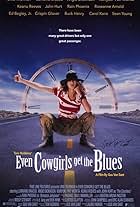Gus Van Sant's intimate black and white tale of l'amour fou has been hailed as a precursor to the American wave of queer cinema that started to swell in the late eighties. Its credentials are established in the opening lines as Walt (Tim Streeter), a counter jockey at a hole-in-the-wall liquor store, gazes upon Johnny (Doug Cooeyate), an illegal Mexican immigrant with fleshy lips, a wide, youthful grin, and a streak of juvenile machismo. "I want to drink this Mexican boy, Johnny Alonzo," he rhapsodizes in voice-over, and he spends the rest of the movie doing all he can to get next to this beautiful boy ("He says he's 18, but he's probably 16," Walt confesses). Johnny is full of attitude and sass and contempt for his gay admirer, but not too proud to take advantage of Walt's desire for his company to score a handout at the store or a turn behind the wheel of Walt's car (which he pilots with the reckless mania of a teenager on a video game).
The film was shot for $25,000 on 16mm black-and-white film and captures the physical and social atmosphere of Portland's run down Northwest area, of transient motels and liquor in corner stores and a homeless population loitering in the streets, with such vivid detail that you can recognize the authenticity without ever having set foot in the real life location.






















